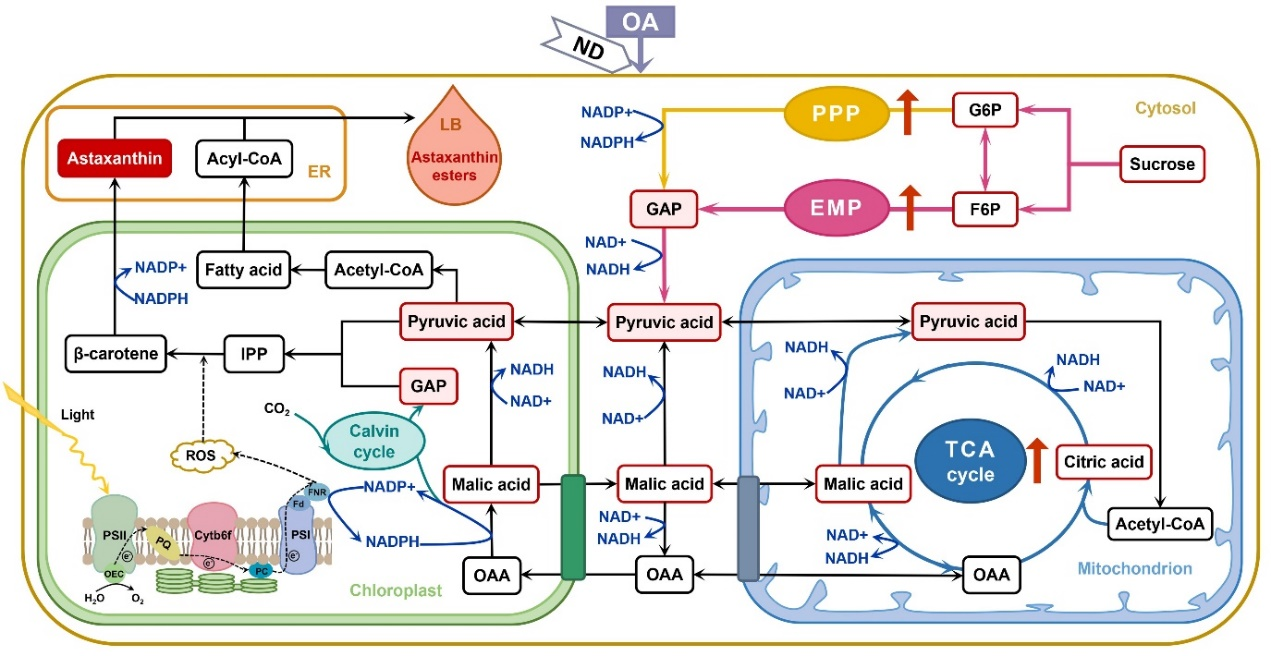New achievement of theoretical and technological research in the resource development of Haematococcus astaxanthin
Astaxanthin has multiple application prospects in nutraceuticals, pharmaceuticals aquaculture and cosmetics owing to its strong colorant, antioxidant capacity and other biological functions. H. pluvialis, a unicellular green alga rich in astaxanthin, is recognized worldwide as the best biological resource for producing natural astaxanthin.
Traditionally, astaxanthin biosynthesis in H. pluvialis was considered to be inducted mainly by both high light and/or nutrient deficiency. Therefore, most previous studies on the regulation of astaxanthin biosynthesis and accumulation have been focused on the light-dependent metabolic pathways, such as photosynthesis and photoprotection, with little attention paid to respiration.
Only a few studies concerning respiration involved the light-dependent respiratory metabolism, such as the team led by prof. Jianguo Liu found that photorespiration plays an important role in regulating astaxanthin synthesis in H. pluvialis (Algal Research, 2019, 41: 101520), and that chlororespiration protected the green motile of H. pluvialis against photodamage by minimizing the inhibition of the repair of the photodamaged PSII rather than by directly suppressing the photodamage to PSII (Algal Research, 2021, 54: 102140).
However, there are few domestic and overseas reports on the role of light-independent respiratory pathway during astaxanthin accumulation.
Recently, the research team of Algae and Algal Biotechnology led by prof. Jianguo Liu of Institute of Oceanology, Chinese Academy of Sciences, found that light-independent metabolic pathways such as the Embden-Meyerhof-Parnas (EMP) pathway, tricarboxylic acid (TCA) cycle, pentose phosphate pathway (PPP) and alternative oxidase (AOX) respiratory pathway also play very important roles in regulating astaxanthin accumulation in this unicellular green alga.
The relevant theoretical achievements were published in the forms of three research articles in Bioresource Technology, which is a top I international journal of bioresource engineering technology (IF=9.642). And the derived technical achievements have declared four Chinese National Invention Patents, two of which have been patented.
Prof. Liu’s research team recently found number of light-independent respiratory pathways strongly involved in regulating astaxanthin biosynthesis in H. pluvialis. One article revealed the activity of mitochondrial alternate oxidase (AOX) pathway has significant negative correlation with astaxanthin accumulation in H. pluvialis. Based on this discovery, a new viewpoint that regulating respiration would promote astaxanthin biosynthesis in H. pluvialis was firstly proposed.
Another two research articles investigated the effects of exogenous respiratory metabolic intermediates on astaxanthin synthesis, and further proved that TCA cycle can provide carbon skeletons for astaxanthin biosynthesis in H. pluvialis.
The above achievements improved the theory and technique system for industrial development of producing natural astaxanthin from H. pluvialis. It will be conducive to completing the H. pluvialis development model based on the cell cycle control and large-scale closed photobioreactor construction, and then promote the development of this industry to a high new level.
Meanwhile, these results could provide inspiration and reference for the research and resource development of other secondary metabolites especially for producing microalgal carotenoids.
The above research works were funded by the National Key Research and Development Program of China, and the National Natural Science Foundation of China, etc.

Fig. 1 A model diagram of the regulation of astaxanthin synthesis by light-independent respiratory pathway
(1) Zhang LT, Zhang CH, Xu R, Yu WJ, Liu JG. A strategy for promoting carbon flux into fatty acid and astaxanthin biosynthesis by inhibiting the alternative oxidase respiratory pathway in Haematococcus pluvialis. Bioresource Technology, 2021, 344: 126275.
https://www.sciencedirect.com/science/article/abs/pii/S0960852421016175?via%3Dihub
(2) Yu WJ, Zhang LT, Zhao J, Liu JG. Exogenous sodium fumarate enhances astaxanthin accumulation in Haematococcus pluvialis by enhancing the respiratory metabolic pathway. Bioresource Technology, 2021, 341: 125788.
https://www.sciencedirect.com/science/article/abs/pii/S0960852421011299?via%3Dihub
(3) Yu WJ, Zhang LT, Zhao J, Liu JG. Enhancement of astaxanthin accumulation in Haematococcus pluvialis by exogenous oxaloacetate combined with nitrogen deficiency. Bioresource Technology, 2021, 126484.
https://www.sciencedirect.com/science/article/abs/pii/S0960852421018265